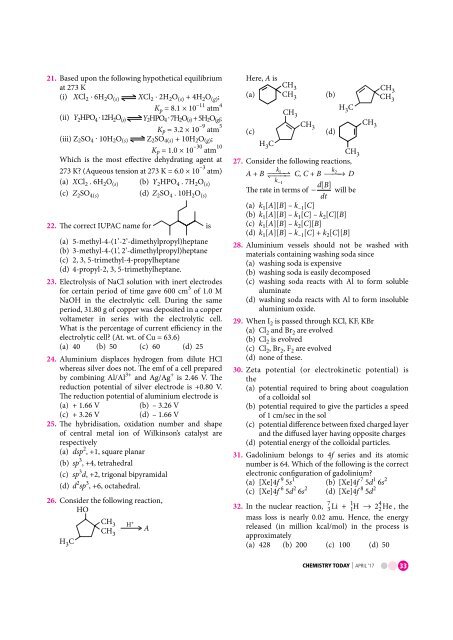Chemistry_Today_April_2017_vk_com_stopthepress
You also want an ePaper? Increase the reach of your titles
YUMPU automatically turns print PDFs into web optimized ePapers that Google loves.
21. Based upon the following hypothetical equilibrium<br />
at 273 K<br />
(i) XCl 2 ⋅ 6H 2 O (s) XCl 2 ⋅ 2H 2 O (s) + 4H 2 O (g) ;<br />
K p = 8.1 × 10 –11 atm 4<br />
(ii) Y 2 HPO 4 ⋅ 12H 2 O (s) Y 2 HPO 4 ⋅ 7H 2 O (s) + 5H 2 O (g) ;<br />
K p = 3.2 × 10 –9 atm 5<br />
(iii) Z 2 SO 4 ⋅ 10H 2 O (s) Z 2 SO 4(s) + 10H 2 O (g) ;<br />
K p = 1.0 × 10 –30 atm 10<br />
Which is the most effective dehydrating agent at<br />
273 K? (Aqueous tension at 273 K = 6.0 × 10 –3 atm)<br />
(a) XCl 2 . 6H 2 O (s) (b) Y 2 HPO 4 . 7H 2 O (s)<br />
(c) Z 2 SO 4(s)<br />
(d) Z 2 SO 4 . 10H 2 O (s)<br />
22. The correct IUPAC name for is<br />
(a) 5-methyl-4-(1’-2’-dimethylpropyl)heptane<br />
(b) 3-methyl-4-(1’, 2’-dimethylpropyl)heptane<br />
(c) 2, 3, 5-trimethyl-4-propylheptane<br />
(d) 4-propyl-2, 3, 5-trimethylheptane.<br />
23. Electrolysis of NaCl solution with inert electrodes<br />
for certain period of time gave 600 cm 3 of 1.0 M<br />
NaOH in the electrolytic cell. During the same<br />
period, 31.80 g of copper was deposited in a copper<br />
voltameter in series with the electrolytic cell.<br />
What is the percentage of current efficiency in the<br />
electrolytic cell? (At. wt. of Cu = 63.6)<br />
(a) 40 (b) 50 (c) 60 (d) 25<br />
24. Aluminium displaces hydrogen from dilute HCl<br />
whereas silver does not. The emf of a cell prepared<br />
by <strong>com</strong>bining Al/Al 3+ and Ag/Ag + is 2.46 V. The<br />
reduction potential of silver electrode is +0.80 V.<br />
The reduction potential of aluminium electrode is<br />
(a) + 1.66 V<br />
(b) – 3.26 V<br />
(c) + 3.26 V<br />
(d) – 1.66 V<br />
25. The hybridisation, oxidation number and shape<br />
of central metal ion of Wilkinson’s catalyst are<br />
respectively<br />
(a) dsp 2 , +1, square planar<br />
(b) sp 3 , +4, tetrahedral<br />
(c) sp 3 d, +2, trigonal bipyramidal<br />
(d) d 2 sp 3 , +6, octahedral.<br />
26. Consider the following reaction,<br />
HO<br />
CH 3<br />
CH 3<br />
HC<br />
3<br />
H + A<br />
Here, A is<br />
(a)<br />
(c)<br />
CH 3<br />
CH 3<br />
(b)<br />
CH 3<br />
CH 3<br />
(d)<br />
HC 3<br />
HC 3<br />
CH 3<br />
27. Consider the following reactions,<br />
k1<br />
k<br />
A + B ↽<br />
⇀<br />
C, C + B 2→<br />
D<br />
k−1<br />
The rate in terms of − dB [ ] will be<br />
dt<br />
(a) k 1 [A][B] – k –1 [C]<br />
(b) k 1 [A][B] – k 1 [C] – k 2 [C][B]<br />
(c) k 1 [A][B] – k 2 [C][B]<br />
(d) k 1 [A][B] – k –1 [C] + k 2 [C][B]<br />
CH 3<br />
CH 3<br />
CH 3<br />
28. Aluminium vessels should not be washed with<br />
materials containing washing soda since<br />
(a) washing soda is expensive<br />
(b) washing soda is easily de<strong>com</strong>posed<br />
(c) washing soda reacts with Al to form soluble<br />
aluminate<br />
(d) washing soda reacts with Al to form insoluble<br />
aluminium oxide.<br />
29. When I 2 is passed through KCl, KF, KBr<br />
(a) Cl 2 and Br 2 are evolved<br />
(b) Cl 2 is evolved<br />
(c) Cl 2 , Br 2 , F 2 are evolved<br />
(d) none of these.<br />
30. Zeta potential (or electrokinetic potential) is<br />
the<br />
(a) potential required to bring about coagulation<br />
of a colloidal sol<br />
(b) potential required to give the particles a speed<br />
of 1 cm/sec in the sol<br />
(c) potential difference between fixed charged layer<br />
and the diffused layer having opposite charges<br />
(d) potential energy of the colloidal particles.<br />
31. Gadolinium belongs to 4f series and its atomic<br />
number is 64. Which of the following is the correct<br />
electronic configuration of gadolinium?<br />
(a) [Xe]4f 9 5s 1 (b) [Xe]4f 7 5d 1 6s 2<br />
(c) [Xe]4f 6 5d 2 6s 2 (d) [Xe]4f 8 5d 2<br />
7 1<br />
32. In the nuclear reaction, 3 Li + 1H → 2 4<br />
2 He , the<br />
mass loss is nearly 0.02 amu. Hence, the energy<br />
released (in million kcal/mol) in the process is<br />
approximately<br />
(a) 428 (b) 200 (c) 100 (d) 50<br />
CHEMISTRY TODAY | APRIL ‘17 33


